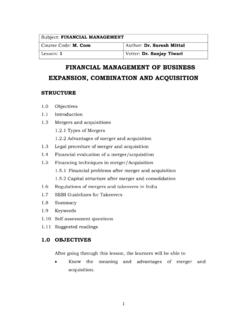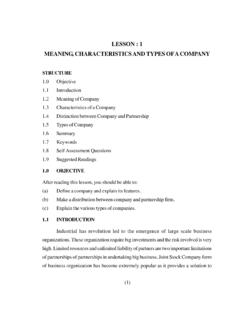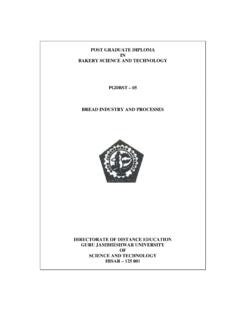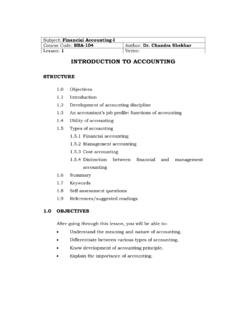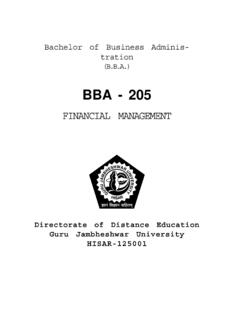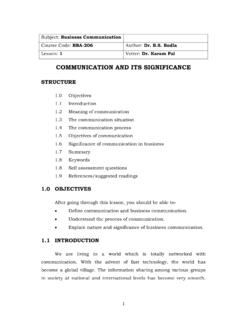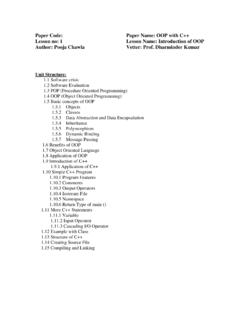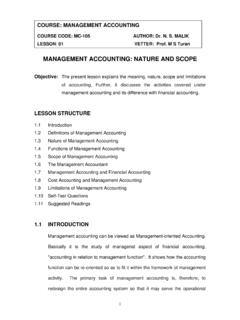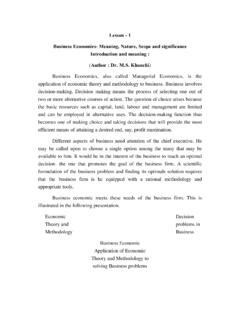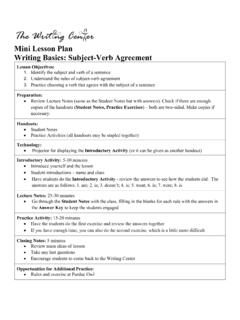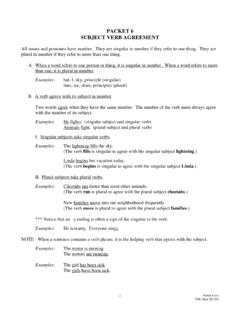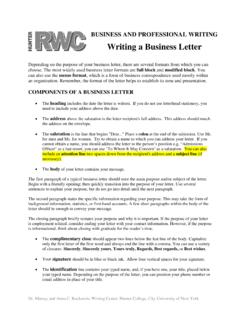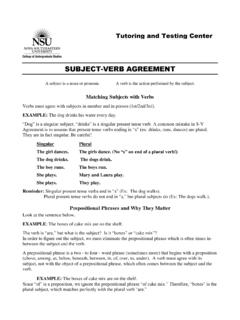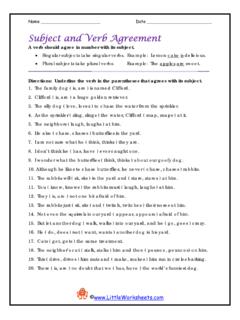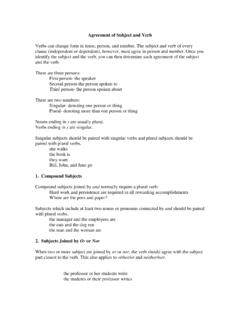Transcription of SUBJECT VERB CONCORD
1 Course Code - BBA 106 Writer Dr. Seema Miglani Lesson No. - 01 Vetter SUBJECT verb CONCORD STRUCTURE Objective Introduction Rules for SUBJECT verb agreement Summary Key words Self Assessment Questions Set 1 Set 2 Suggested Readings Objective The objective of this lesson is to teach the students to write grammatically correct sentences having a perfect harmony between the SUBJECT and the verb . After going through the lesson and practicing the rules of the CONCORD , they will be able to avoid errors of verbs regarding their being singular or plural and use the correct number and person of the verb in a sentence. Introduction CONCORD literally means harmony, agreement . Thus, it means harmony between different members of a group. When we talk of sentences, CONCORD means harmony or agreement between different parts of a sentence, specially the SUBJECT and the verb .
2 Every sentence says something about a person or thing. The part of a sentence that names the person or thing is called SUBJECT or the part, which gives us information about the SUBJECT is called Predicate. The SUBJECT of a sentence thus has a close relation to what is being said in the Predicate. The form of the verb should be in direct relation to the number and person of the SUBJECT . Rules for SUBJECT - verb agreement The verb must agree with the SUBJECT in Number and Person. If the SUBJECT is singular, the verb should also be singular. If the SUBJECT is plural, the verb should also be plural, , He is a good boy. (singular SUBJECT , singular verb ) They are good players (plural SUBJECT , plural verb ) When two or more singular subjects are joined together by and , plural verb is used. , Ram and Sham are playing a game. He and his friends have arrived.
3 If two singular nouns refer to the same person or thing, the verb must be singular, , My friend and benefactor has come. By the death of Gokhale a great statesman and patriot was lost to India. It should be noted that the article is used only once if the two nouns refer to the same person. If different persons were referred to, the article would be used before each noun and the verb would be plural. , The orator and the statesman are dead. If two subjects together express one idea, the verb will be in the singular, , Early to bed and early to rise makes a man healthy, wealthy and wise. Slow and steady wins the race. If singular subjects have each or every before them, the verb is usually singular. , Every man, woman and child was lost. Each day and each hour brings its duty. Two or more singular subjects connected by or , nor , either , neither or nor take a verb in the singular, , Neither Hari nor Ravi has come.
4 No nook or corner was left unexplored. When the subjects joined by or , nor are of different numbers, the verb must be plural, and the plural SUBJECT must be placed next to the verb . , Hari or his brothers have done this. Either the boy or his parents have gone there. When the subjects joined by or , nor are of different persons, the verb agrees in person with the one nearest to it, , Either he or I am mistaken. Neither you nor he is to blame. A collective noun takes a singular verb when the collection is thought of as a whole. , The counsel has chosen its president. The fleet has set sail. It should however be kept in mind that if the individuals of which the collective noun is composed of are thought of, it can take a plural verb . , The military work called out. The crew were taken prisoners. Some nouns which are plural in form, but singular in meaning, take a singular verb , , The news is true.
5 Physics is a branch of natural science. When a plural noun counts between a singular SUBJECT and its verb , the verb used is singular in form. , Each of the sisters is clever. A variety of objects charms the eye. The quality of the mangoes was not good. Words joined to a singular SUBJECT by with, together with, in addition to or as well as are parenthetical and therefore do not affect the number of verb . , The chief, with all his men, was killed Justice as well as mercy, allows. When the SUBJECT of the verb is a relative pronoun, care should be taken to see that the verb agrees in number and person with the antecedent of the relative. , I, who am your friend, will guard you interest. You, who are my friend, should not worry me. The title of a book, play, story, musical composition and the name of a country, even though plural in form take a singular verb , , Sons and Lovers is an interesting Novel. The United States of America is a developed country.
6 Summary The basic rules for writing grammatically correct sentences have been discussed. In a sentence, the verb must agree with its SUBJECT with respect to its number and person. Key words SUBJECT , verb , predicate, noun, pronoun, singular, plural. Self Assessment Questions Set 1 Fill in the blanks with correct form of the verb : 1. Two and two .. four. 2. Bread and butter .. take wholesome food. 3. Gulliver s travels .. written by swift. 4. A good man and useful citizen ..passed away. 5. Each of the 6. The in their opinion. 7. He is one of the authors to be immortal. 8. Neither of the at his ease. 9. The cost of these 10. Every leaf and every off the tree. 11. The horse and waiting for a long time. 12. The Arabian many generations. 13. Kindness as well as be our guide. 14. No news ..good news. 15. Forty yards ..a good distance. 16. The meeting ..chosen a president. 17. The not to walk on the grass.
7 18. Iron as well as in India. 19. Which one of these 20. To take pay and then not to do Set 2 Correct the following sentences: 1. Sita as well as Ram like fruit. 2. The owner of these houses are very clever. 3. There is eleven players in the ground. 4. Rice and curry are his favourite dish. 5. Great Expectations are a good book. 6. Both of the books requires careful reading. 7. Neither Tina nor his friends is going there. 8. A doctor as well as a nurse are working in the hospital. 9. A doctor and a nurse is working in the hospital. 10. A number of books is missing. Suggested Readings J. Thomson & A. V. Martinet, A Practical English Grammar for Foreign Students, Oxford University Press, India 1963. Prasada Rao, Learners' English Grammar and Composition, S. Chand & Company Ltd, New Delhi, 1998. Michael Swan, Oxford Pocket Basic English Usage, Oxford University Press, India, New Delhi, 1992 Raymond Murphy, Intermediate English Grammar, Cambridge University Press, New Delhi, 1994 Course Code - BBA 106 Writer Dr.
8 Seema Miglani Lesson No. - 02 Vetter Mrs. Maneesha FORMS OF VERBS STRUCTURE Objective Introduction Forms of Verbs Using verb Tenses Present tense Past tense Future tense Moods Modal verbs and Auxiliary Phrasal Verbs Summary Key words Self Assessment Questions Suggested Readings _____ Objective The objective of this lesson is to make the students understand about verb and its forms, and their usage. Introduction A verb is a word or a group of words that denotes action, or the state in which a thing or a person is, or joins the SUBJECT with the rest of the sentence. There has to be at least one verb in the sentence to make it a sentence. A verb often consists of more than one word. For example: The baby laughs. The man is a doctor. The weather seems bad. In the first sentence, the verb laughs tells us about action. In the second, the verb is tells us about what the man is.
9 In the last, the verb is again stating about the condition of the weather. Thus, a verb states something about the SUBJECT of the sentence and expresses action, events or states of being. It forms a part of the predicate of a sentence. Forms of Verbs Read the following sentences carefully: 1. Ram kills the snake. 2. The boy laughs loudly. In sentence 1, the action denoted by the verb kills passes over from the doer or the SUBJECT Ram to the object snake . The verb kills is, therefore, called a Transitive verb . In sentence 2, the action denoted by the verb laughs stops with the doer , the boy, it does not pass over to any object. It does not affect any noun other than the doer. The verb laughs is, therefore, called an Intransitive verb . Most Transitive verbs take a single object, however, verbs such as give, ask, offer, promise, tell, .. take on two objects after them an object that denotes the person to whom something is given or for whom something is done, and a direct object which is usually the name of things.
10 Using verb Tenses A verb indicates the time of the action by changing its form. The tenses are determined according to the time frame viz. present tenses, past tenses and future tenses. Present tense: 1. The simple present (We go). Form: First form of the verb The verb describes things, situations or actions that are present now and are habitually true. The sun rises in the east. (always true) He goes for a walk every morning. (habitually true) 2. The present continuous (We are going). Form: is/am/are + -ing form of the verb . The verb describes a particular action that is taking place at the time of speaking and is in progress. The baby is sleeping. He is writing a letter. 3. The present perfect (We have gone). Form: has/have + third form (past participle) of the verb . The verb describes an action that started sometimes in the past and continues up to the present. They have gone to Bombay.
